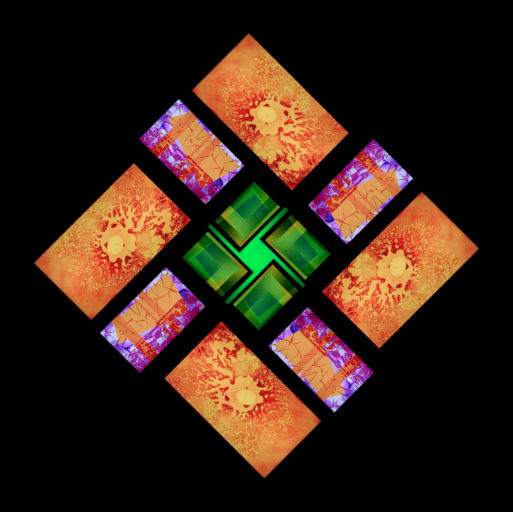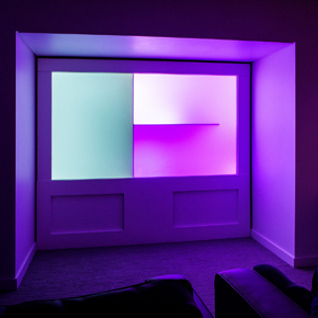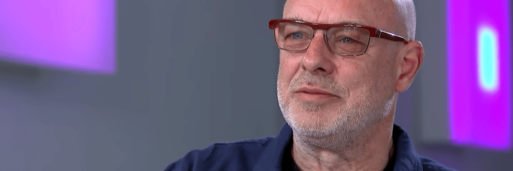
A randomly-generated image from Brian Eno’s art piece, “77 Million Paintings”
Credit: flickr.com
The sterile setting of a hospital might be the last place you’d imagine seeing an immersive, experimental work of art by Brian Eno. But this is exactly where he wanted his music and visual art to reside. Brian Eno’s “The Quiet Room” is an art installation designed to calm patients and help them heal. Located at the Montefiore Hospital in Hove, England, “The Quiet Room” is a stunning work of art in itself. But when it’s viewed in the context of the hospital setting, it moves beyond visual and audio aesthetics, becoming a tool for patients to cope with terminal illnesses.
So, how did a world-famous artist and musician like Brian Eno wind up designing a healing art installation for a hospital? It all started at a festival in Brighton.
In 2013, the Montefiore Hospital’s staff was asked to contribute ideas for a redesign of the hospital’s interior. Doctors wanted to add more art to the building in order to make patients feel more comfortable and calm during their visits. Montefiore surgeon Robin Turner immediately suggested Brian Eno as a candidate for the task.
Turner had recently seen one of Eno’s art installations at a festival in Brighton, observing that it had a calming effect on his mother-in-law. Normally an anxious person, Turner’s mother-in-law spent two hours quietly watching Eno’s art at the festival, and Turner says she has never appeared more calm. He wanted his patients to have the same experience at Montefiore Hospital.
Soon after, the hospital’s parent company, The Spire Healthcare group, contracted Eno for two art installations: one in the lobby, and one in a separate room downstairs. This room would later become Brian Eno’s “The Quiet Room.”
The art in the lobby isn’t as immersive as Brian Eno’s “The Quiet Room,” yet it still sets a calming tone for anyone who walks through the hospital doors. Eight high-definition plasma screens, each showing a work of visual art by Eno, greets patients and visitors as they walk through the doors. The screens play Eno’s famous “77 Million Paintings” on a loop.
To make the piece, Eno created a series of abstract paintings, and then designed computer software that would choose any layer of a painting at-random. From here, the software combines the random layer with one of Eno’s other paintings. Thus, every few seconds, the software creates a brand new work of abstract visual art that will likely never exist again. This gives viewers at least 77 million new interpretations throughout the installation’s lifespan. As Eno’s soft, ambient compositions play in the background, the lobby offers patients and families a moment to unwind before they see their doctors.
A Place to Regroup
By contrast, Brian Eno’s “The Quiet Room” is a far more immersive and emotionally-driven experience for patients and their families. Eno took a minimalist approach to the room, with just three color-changing light panels and soothing ambient music. The goal was to create a space where patients can be alone with their thoughts while also feeling supported. The soft lighting changes and the subtlety of Eno’s original music compositions bring warmth into the space without introducing too many distracting elements.
Brian Eno’s “The Quiet Room” has already been a major success for the Montefiore Hospital’s patients and families. One patient, a man who recently learned he has cancer, said that the room is like a “cocoon.” He was able to sit in the space after his diagnosis to process the news. Later, it helped him cope with the side effects of his treatment.
Music in particular has a beneficial impact on health, especially for patients who have recently learned they have a terminal illness. “The Quiet Room” is more than just a beautiful work of immersive art. It gives patients the much-needed space they need to be alone with their own thoughts and escape the stress of the world outside.
To learn more about the value of sound in healing, check out our interview with award-winning electronic musician Yoko Sen.

 Brian Eno’s “The Quiet Room” Meshes Art with Wellness
Brian Eno’s “The Quiet Room” Meshes Art with Wellness




 Recovering Cremation Remains After the Los Angeles Fires
Recovering Cremation Remains After the Los Angeles Fires
 “As Tears Go By” by Marianne Faithfull
“As Tears Go By” by Marianne Faithfull
 “The Sea” by John Banville
“The Sea” by John Banville














